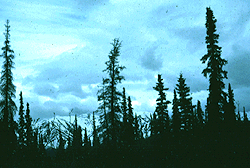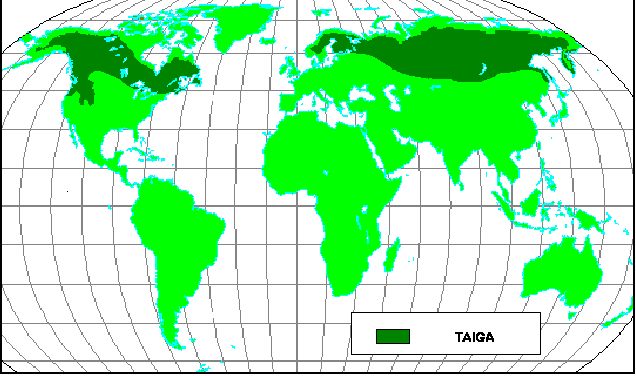 |
 |
 |
 |
Introduction.The taiga or boreal forest exists as a nearly continuous belt of coniferous trees across North America and Eurasia. Overlying formerly glaciated areas and areas of patchy permafrost on both continents. Taiga is the Russian name for this forest which covers so much of that country. However, the term is used in North America as well.
Climate: The taiga corresponds with regions of subarctic and cold continental climate . Long, severe winters (up to six months with mean temperatures below freezing) and short summers (50 to 100 frost-free days) are characteristic, as is a wide range of temperatures between the lows of winter and highs of summer. For example, Verkhoyansk, Russia, has recorded extremes of minus 90 ° Fand plus 90 ° F. Mean annual precipitation is 15 to 20 inches, but low evaporation rates make this a humid climate.
Vegetation: Needleleaf, coniferous trees are the dominant plants of the taiga biome. A very few species in four main genera are found: the evergreen spruce (Picea), fir (Abies), and pine (Pinus), and the deciduous larch or tamarack (Larix). In North America, one or two species of fir and one or two species of spruce are dominant. Across Scandanavia and western Russia the Scots pine is a common component of the taiga.
Growthforms: The conical or spire-shaped needleleaf trees common to the taiga are adapted to the cold and the physiological drought of winter and to the short-growing season:
Soil: Soil in these areas is often acidic.
Other Common Environments Present: Environmental conditions result in sometimes extensive, persistent patches of vegetation other than spruce and fir:
Fauna: Fur-bearing predators like the lynx (Felis lynx) and various members of the weasel family (e.g., wolverine, fisher, pine martin, mink, ermine, and sable) are perhaps most characteristic of the boreal forest proper. The mammalian herbivores on which they feed include the snowshoe or varying hare, red squirrel, lemmings, and voles.
Large herbivores are more closely associated with successional stages where there is more nutritious browse available and include elk or wapiti (Cervus elaphus, known as red deer in Europe) and moose (Alces alces, known as elk in Europe). The beaver (Castor canadensis), on which the early North American fur trade was based, is also a creature of the taiga.
Among birds, insect-eaters like the wood warblers are migratory and leave after the breeding season. Seed-eaters (e.g., finches and sparrows) and omnivores (e.g., ravens) tend to be year-round residents. During poor cone years, normal residents like the evening grosbeak, pine siskin, and red crossbill leave the taiga in winter.
In North America, several variants of the boreal forest occur in the mountains of the West.